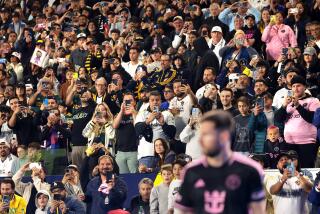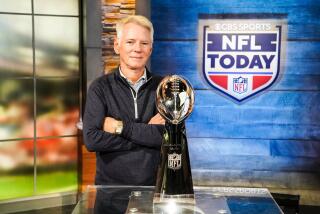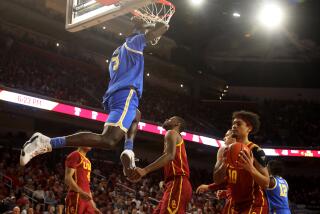A Big Splash, Then No Cash : WFL Made History in 1974, but ‘Whiffle Ball’ Didn’t Last
- Share via
Twenty years ago today, a couple of Newport Beach lawyers with hair over their ears and wide lapels shook the National Football League to its core by putting a bold experiment, the World Football League, on page one.
Today, it’s hard to imagine anyone getting excited about a $3-million contract for one athlete, let alone three. But the WFL wanted shock value, and that’s how much it had to pay for Miami Dolphin stars Larry Csonka, Jim Kiick and Paul Warfield.
The engineers behind the deal were Gary Davidson and Don Regan, the Newport Beach lawyers who organized the league.
Starting in the fall of 1973 and continuing in early 1974, there had been a smattering of stories about a new pro football league. But the reaction was mostly snickering, particularly after the WFL said it would play on Wednesday nights--with a yellow football.
“Whiffle ball,” NFL people called it, often with a sneer.
But on Sunday afternoon, March 31, 1974, all the WFL jokes stopped.
Csonka, Kiick and Warfield appeared with Howard
Cosell on ABC that day and announced they had signed to play for the WFL’s Toronto--later to become Memphis--franchise in 1975.
It was a $3-million deal, the largest sports contract in history to that point, and a sensational news story. It gave the WFL instant credibility, and it made the half-century-old NFL tremble a bit, if but for a few months.
Kiick and Warfield were key performers at Miami, and Csonka is still perhaps the most effective fullback of the last 30 years. Moreover, all three were stars in a Dolphin dynasty, which began with Miami’s perfect 17-0 1972 season.
Around the NFL, executive office doors were shut the next morning. Owners huddled with general managers and coaches, taking a close look at players who might jump.
Plenty did. Quarterback Virgil Carter had been the first to go. After him came veterans Calvin Hill, Ted Kwalick, Daryle Lamonica, Dick Witcher, John Elliott, Gerry Philbin, George Sauer and others.
In early 1973, Davidson and Regan found franchise owners in Anaheim, Birmingham, Chicago, Detroit, Orlando, Honolulu, Houston, Jacksonville, Toronto, New York (later Charlotte), Philadelphia and Portland.
Early in league meetings, it was agreed the league needed to sign a big-name NFL player early and parlay that into season-ticket sales and a TV contract.
Prime target: Joe Namath.
“We had a lot of meetings with Namath’s agent, a guy no one could stand, and we just weren’t getting anywhere,” Regan recalled recently. “Then the IMG (International Management Group) guy who represented Kiick, Csonka and Warfield contacted John Bassett, who at the time owned the WFL’s Toronto franchise, and told him the three players’ options would be up after the ’74 season and that they wanted to talk to us.
“Bassett called us about it, and we called a league meeting. Everyone agreed we needed to sign all three guys. We forgot about Namath. Bassett paid for half the deal, and the rest of the owners chipped in the rest.
“The deal was agreed to, but no one outside the league knew about it. The three players went to Miami and asked (Dolphin owner) Joe Robbie if he wanted to match the deal, and he blew up and threw them out of his office.”
The next day, an angry Robbie told a reporter: “Has anyone ever asked you to deposit $3 million in a bank as the price to continue a conversation?”
The numbers, in 1974, were breathtaking: Csonka, 27, got $500,000 up front and a $325,000 salary for three years. Warfield, 31, signed for a $220,000 salary. Kiick, 27, signed for $150,000. The three would join the new league in 1975, but not in Toronto.
The Canadian Parliament threw the WFL out of Canada, claiming it would endanger the Canadian Football League. Bassett moved to Memphis.
*
Paying high-profile athletes to jump leagues didn’t begin with the WFL’s signing of Csonka, Warfield and Kiick.
When Davidson and Regan organized the World Hockey Assn. in 1972, they passed the hat among owners, extracted $90,000 from each, and wrote a $1-million check to bring Bobby Hull out of the National Hockey League.
Previously, Davidson and Regan created the American Basketball Assn., which later merged with the NBA.
After the WFL signed Csonka, Warfield and Kiick, business moved along briskly for the new league, headquartered in a two-story office building a stone’s throw from Orange County Airport.
After Miami’s Big Three signed, it seemed as if an NFL player jumped every day. Colorful uniforms--the Southern California Sun team colors were magenta and orange--were purchased. Season tickets went on sale. Schedules were made.
There was no network TV package, but an independent syndicator, TVS, televised the league’s “game of the week” on Thursday nights.
The signing of the Miami Three almost put Davidson on the cover of Sports Illustrated before the first league game. The magazine photographed him with Kwalick and Hill. It was to be the cover in April, 1974.
Unhappily for Davidson, Hank Aaron chose the same week to hit his 715th career home run, the day before the Davidson SI cover edition was to go to press. Today, a copy of the never-seen cover hangs on Davidson’s office wall in Costa Mesa.
When the games began, optimism was sky high. The league’s first game was July 10, 1974, a Wednesday night Southern California-Birmingham game at 72,000-seat Legion Field in Birmingham.
A crowd of more than 50,000 showed up, and Davidson was cheered loudly before the game. “I’m overwhelmed,” he said at the time.
“I remember thinking to myself that night: ‘I’ll never have to prove myself again,’ ” he said recently.
In the first weeks, there were no sellouts, but crowds were decent-sized almost everywhere. A good base upon which to build, everyone agreed.
Then, two trouble signs:
--In a televised game at Philadelphia’s 100,000-seat JFK Stadium, before an announced paid crowd of about 10,000, hundreds of small boys poured out of end zone seats, chasing loose balls.
The next day, columnists everywhere wondered if the mobs of kids were included in the paid crowd count.
--Ownership in Detroit informed league officials in Newport Beach that they soon would be unable to make their payroll. Shortly afterward, a similar report came in from Jacksonville.
The Philadelphia Bell team admitted that 100,000 of its first 120,000 “sold” tickets were either freebies or sold at big discounts.
In Detroit, the Wheels’ program printer loudly demanded cash.
In Jacksonville, after it got out that owner Fran Monaco had team debts of $1.8 million, he said: “I never said I was Lamar Hunt.”
It was the beginning of the end.
Davidson recently talked about the first signs of trouble.
“In 1991, I was asked to speak at the Harvard Business School about our WFL experience,” he said.
“I likened it to being in a mountain small-plane crash in a snowstorm with 10 people aboard. Six are very seriously injured and four are uninjured.
“The uninjured have a dilemma: Do they endanger the safety of the entire group by trying to carry out the injured?
“We did that in the WFL, and it was a mistake. We let Detroit and Jacksonville stay in, and the rest of the league covered their losses.
“If we’d folded those two up at the outset of trouble, I’m convinced today the league would have survived, that it would have had a network TV contract in its third year, that we’d have merged with the NFL a few years after that and that cities like Memphis and Birmingham would today be NFL cities.”
Covering Detroit’s and Jacksonville’s losses steadily weakened the resolve of the other owners, Davidson added.
“If we could have just made it to ‘76, when the economy turned around, we could have replaced all the owners, if we’d wanted to. Eli Broad (of the Kaufman & Broad construction firm) wanted in.”
In 1974, the WFL limped to the finish line in rising tides of red ink and missed paydays. Players were sleeping on floors and eating canned tuna.
In the aftermath, Davidson and Regan were ousted and the league was reorganized under a new leader, Chris Hemmeter, owner of the Hawaiians franchise.
But 1974 baggage followed the cash-short league in its second and final season, too, even with the arrival of Csonka, Kiick and Warfield.
The WFL officially died on Oct. 22, 1975, late in its second season.
When Tom Fears, coach of the Southern California Sun, told his players the league had folded, 14 of them met at the nearest bar and rallied around 27 pitchers of beer. When the WFL’s obituaries were written, a common critique of the league was that it didn’t make it because Davidson was in too big a hurry, that if he had spent all of 1974 organizing for a 1975 inaugural season, his league would have survived.
“Not true,” he said.
“In 1974, we had the best organization and the best people of any of the three leagues we’d started. If the economy had remained strong and if we’d cut our bad franchises early, we’d have made it.”
*
Today, Csonka is a motivational speaker and co-host of the TV show “American Gladiators” and lives in Lisbon, Ohio. Warfield is president of a management consultant firm in Moraine, Ohio. Kiick is an investigator for the Broward County Public Defender’s Office in Ft. Lauderdale, Fla.
Davidson, 59, is founder and chairman of ARV Housing Group, a Costa Mesa-based firm that builds retirement communities nationwide. Regan, 59, is ARV’s legal counsel. Bassett died of cancer in 1986, at 47.
In 1976, a year after the WFL died, a reporter added up the dollar impact Davidson had on pro sports in America.
Factors covered included everything from higher salaries the NBA, NHL and NFL were forced to pay their athletes to arenas and stadiums built or renovated to accommodate Davidson/Regan leagues. Grand total: Approximately $500 million.
More to Read
Go beyond the scoreboard
Get the latest on L.A.'s teams in the daily Sports Report newsletter.
You may occasionally receive promotional content from the Los Angeles Times.










